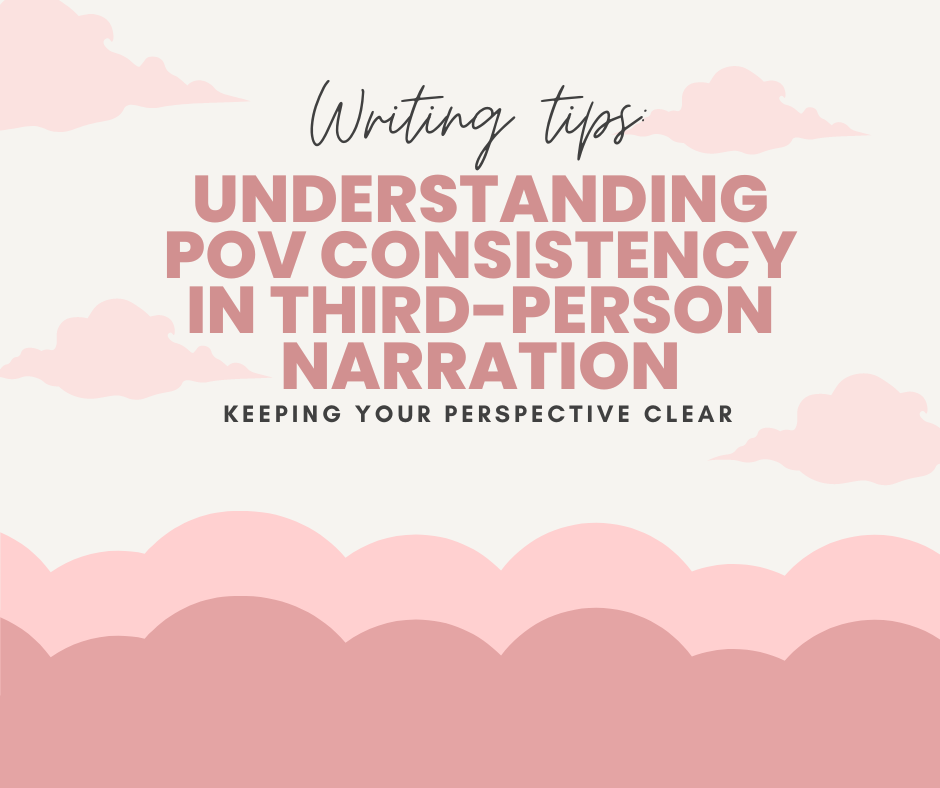Understanding POV consistency in third-person narration: keeping your perspective clear
Point of view (POV) is is a powerful writing tool which can shape how readers will experience your story and connect with characters. But—as with any tool—it’s crucial to use it consistently to avoid jarring the reader out of the narrative. One common issue in manuscripts is when writers inadvertently switch between different types of third-person narration.
This post is going to break down the two most common types of third-person POV—third-person limited and third-person omniscient—and why it’s important to stay consistent with the perspective you choose.

The Types of Third-Person Narration
Before diving into the issue of POV consistency, it’s important to understand the two main approaches to third-person narration that writers commonly use.
1. Third-Person Limited (Character-Focused POV)
In third-person limited, the narrative sticks closely to the perspective of one character at a time. The narrator knows only what this character knows, revealing only what the character can see, hear, think, or feel. Essentially, the narrator is like an invisible observer sitting on the character’s shoulder, reporting the world through that character’s lens.
This POV is a regular fixture in many fiction stories. One of the easiest ways to spot it is when a book uses a character's name as the chapter title, to indicate when the POV is jumping back and forth.
For example:
"Ginny nervously glanced at the clock. She couldn't be late again. Not today—when her boss' temper had been so short as of late and she could practically feel the tension in the office as a palpable, overhanging axe ready to swing."
In this form, we’re seeing the world as Sarah experiences it. The reader only knows what Ginny knows—we don’t have access to other characters' thoughts or knowledge unless Ginny does.
2. Third-Person Omniscient
In contrast, third-person omniscient allows the narrator to know everything about everyone in the story. This all-seeing narrator can jump between different characters’ thoughts, feelings and experiences, as well as share information that none of the characters might be aware of. This gives the writer a lot more flexibility in terms of providing a broader understanding of events.
For example:
"Ginny nervously glanced at the clock, unaware that her boss—sitting just desks down, divided by a thin glass-panelled wall—was stewing over a presentation he was about to deliver to the board. He had no idea she was running late as she careened past colleagues, puffing and out of breath. But, as she ran, all she could think about was the recent tension in the office and how she couldn't be late again. Not today."
Here, the narrator knows what both Ginny and her boss are thinking and feeling, even though neither character knows the other’s thoughts. This type of narration can offer a panoramic view of the story, moving between different characters and events with ease.
The Problem of Inconsistent POV
Now, what happens when these two approaches are mixed unintentionally? This is where the issue of POV inconsistency comes into play.
Imagine you’re reading a chapter that is written in third-person limited, focusing on a single character’s perspective. For example, Ginny is our POV character for the chapter. As readers, we’re locked into Ginny's head, experiencing the world as she does. Then, all of a sudden, the narrator provides information that Ginny wouldn’t have access to—maybe it’s a thought from another character or a detail from an event happening elsewhere.
This kind of switch can be jarring for the reader, as it breaks the immersive experience. In a third-person limited POV, the reader expects to be confined to one character’s perspective at a time. When information outside of that character’s awareness is suddenly introduced, it feels like the rules of the story are being broken. It can also create confusion: whose thoughts are we following now? How do we know this if the character doesn’t?
Example of a POV Break:
"Ginny nervously glanced at the clock. She couldn't be late again. Not today—when her boss's temper had been so short as of late and he'd been stewing all morning about the report he had to give and she had no idea just how much her repeated tardiness would set him off.
In this example, we start in Ginny's perspective, but then the narrator briefly jumps into the boss’s thoughts, revealing something Ginny couldn’t possibly know (because she's running late). This type of shift is subtle but disrupts the consistency of the POV.
Maintaining POV Consistency
To keep your writing clear and immersive, it’s crucial to stick with the type of third-person narration you’ve chosen for each section of the story. If you’re using third-person limited, all information should come through the lens of the character in focus. That means we can only see, hear and know what that character does. If there’s something important that another character knows, you’ll either need to switch to their POV in a different scene (or chapter, if following that convention) or find a way for your POV character to discover that information.
Alternatively, if you want to have more flexibility in revealing information from multiple perspectives, you can opt to write in third-person omniscient— but it’s important to do this consistently throughout your story. In omniscient narration, the narrator can freely offer details about any character, as long as it’s clear that the narrative voice is detached from any single character’s viewpoint.
A Quick Tip for Identifying POV Breaks:
When revising your manuscript, keep these questions in mind:
- Does the character in focus know this information?
- Is the narrator sticking to the perspective of the current POV character?
- Does this moment of insight serve the story well/make contextual sense for this character to know?
If the answer to any of these is “no,” you may have a POV inconsistency that needs adjusting.
Finding the Right Approach for Your Story
There’s no right or wrong answer when it comes to choosing between third-person limited and omniscient—it depends on what kind of story you want to tell. However, staying consistent with your POV choice is essential for maintaining a smooth, engaging narrative.
- If you want the reader to experience the world closely through the eyes of a single character, third-person limited is a great choice.
- If you want the freedom to explore multiple characters' thoughts and experiences without constraint, third-person omniscient can offer a broader, more flexible perspective.
Either way, it’s important to be intentional and consistent with your POV choices to ensure your reader stays grounded in your story.
Conclusion
Understanding the difference between third-person limited and third-person omniscient is key to maintaining POV consistency in your writing. When your story adheres to a clear perspective, it becomes more immersive, making it easier for readers to connect with your characters and follow the narrative. So, whether you choose to keep the focus on one character’s viewpoint or take a more expansive approach, remember to stay consistent and mindful of the rules of the POV you’ve chosen.
Happy writing!


Post a comment